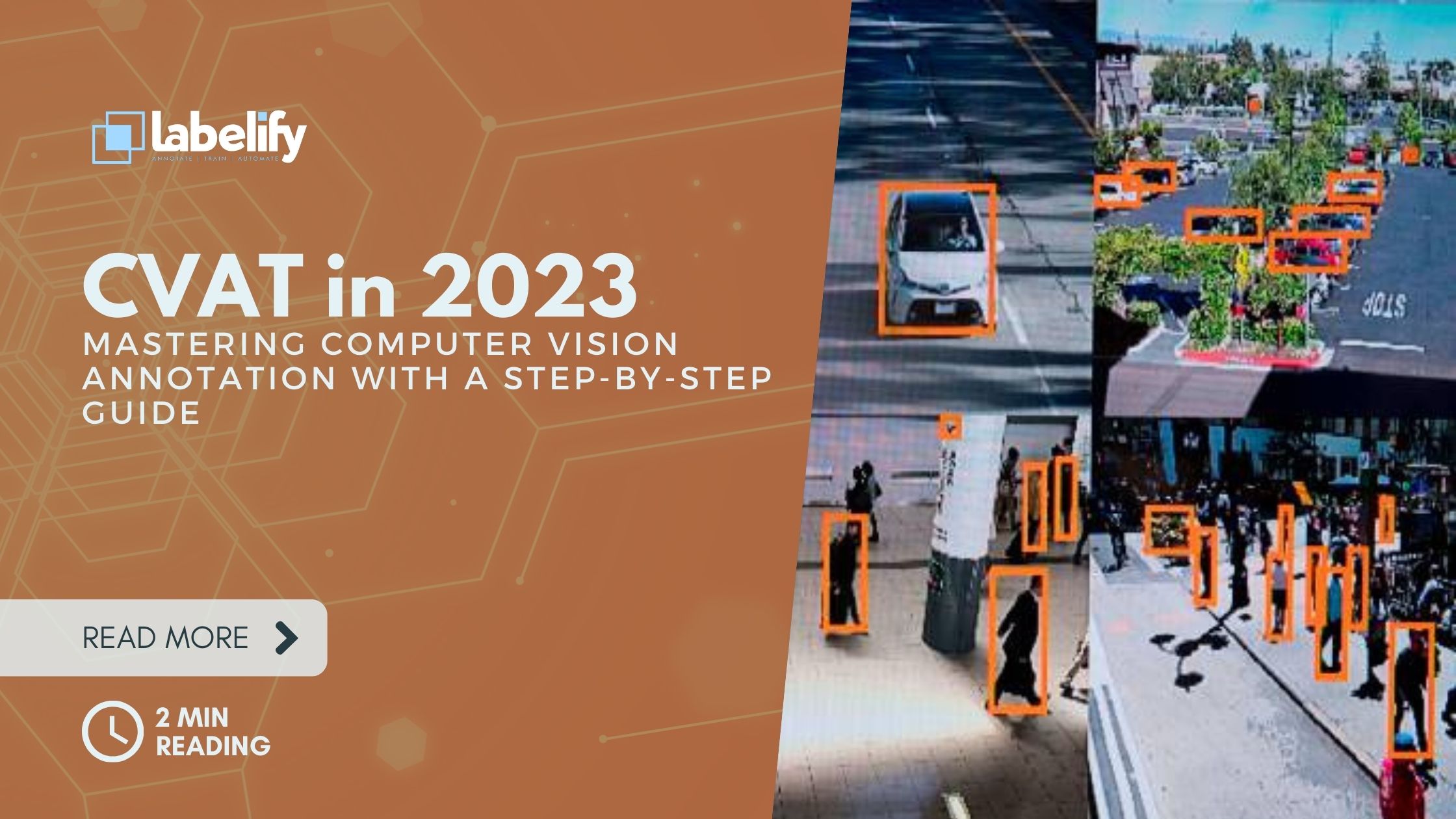Looking for an efficient and powerful annotation tool for your computer vision projects? Look no further! With CVAT, you can easily label data for various tasks like image classification, object detection, and more.
Whether you prefer working online or on your local machine, CVAT has got you covered. It supports multiple annotation formats and offers semi-automatic tools to speed up the process.
Unlock the full potential of CVAT and liberate your computer vision projects today!
Key Takeaways
- CVAT is an open-source image and video annotation tool developed by Intel.
- It supports multiple annotation formats like YOLO, Pascal VOC, and MS COCO.
- CVAT can be used online or installed on a local machine.
- It offers semi-automatic annotation tools to assist in speeding up the annotation process.
Overview of CVAT's Features
When exploring CVAT's features, you'll discover a comprehensive set of tools and functionalities that facilitate efficient and accurate annotation for computer vision tasks.
CVAT stands out among other annotation tools due to its versatility and user-friendly interface. It supports various annotation formats like YOLO, Pascal VOC, and MS COCO, giving you the flexibility to choose the format that best suits your project needs.
CVAT also offers auto-annotation tools, such as interpolation between keyframes and automatic annotation, which can significantly speed up the annotation process.
To ensure efficient annotation using CVAT, it's recommended to follow best practices such as utilizing the semi-automatic annotation features, using interactors to create polygons, detectors to annotate frames, and trackers to annotate objects with bounding boxes.
With CVAT, you have the power to annotate images and videos accurately and efficiently, making it an invaluable tool for computer vision tasks.
Getting Started With CVAT
To begin using CVAT, start by creating an account and accessing the online platform or setting it up on your local machine. Here are three key points to consider:
- CVAT Online vs Local Installation:
- Choose whether to use CVAT online or install it locally on your machine.
- Online annotation allows for easy access and collaboration, while local installation offers unlimited annotation capabilities without platform restrictions.
- CVAT Annotation Formats Comparison:
- CVAT supports multiple annotation formats like YOLO, Pascal VOC, and MS COCO.
- Compare these formats to determine which one best suits your computer vision task requirements.
- Getting Started:
- If you choose the online option, create an account on cvat.org, upload your data, and configure the labeling task settings.
- Start annotating by selecting a label and drawing the annotation.
- If you prefer the local installation, follow the installation instructions specific to your operating system and enjoy annotation freedom without online platform limitations.
CVAT provides the flexibility and freedom you need to efficiently annotate data for your computer vision projects, whether you choose the online platform or a local installation.
Installing CVAT on Your Local Machine
If you prefer to have unlimited annotation capabilities without platform restrictions, you can install CVAT on your local machine. By setting up CVAT locally, you can customize the interface to suit your needs and annotate large amounts of data without limitations.
To install CVAT on your local machine, follow the installation instructions provided for your operating system. Make sure to install WSL2, Docker Desktop, Git, and Google Chrome as prerequisites.
Setting up CVAT locally will liberate you from online platform restrictions and allow you to have full control over your annotation process. In case you encounter any issues during the installation process, CVAT provides troubleshooting guides to help you resolve common problems.
Take advantage of this opportunity to have total freedom and flexibility in your annotation workflow.
CVAT's Auto-Annotation Tools
Now let's delve into CVAT's Auto-Annotation Tools, which provide additional assistance in speeding up the annotation process while improving quality and efficiency. Here are three reasons why these tools are a game-changer:
- Interactors vs. Detectors: Which auto annotation tool is more efficient? CVAT offers both interactors and detectors as auto-annotation tools. Interactors allow you to create polygons semi-automatically, while detectors automatically annotate one frame. This gives you the flexibility to choose the tool that suits your specific annotation needs.
- Comparing CVAT's auto annotation tools with other annotation platforms. CVAT stands out from other annotation platforms by providing a comprehensive set of auto-annotation tools. These tools not only save time but also ensure high-quality annotations. With CVAT, you can achieve accurate and efficient annotations without compromising on precision.
- Increased productivity and reduced overheads. By utilizing CVAT's auto-annotation tools, you can significantly boost your productivity. The automation reduces the manual effort required for annotation, allowing you to focus on more complex tasks. This not only saves time but also reduces the overall cost of the annotation process.
CVAT's Auto-Annotation Tools revolutionize the annotation process, providing efficiency, precision, and cost-effectiveness.
Pros and Cons of CVAT
CVAT has both advantages and disadvantages that should be considered when choosing an annotation tool for computer vision tasks.
One of the major pros of using CVAT is its versatility. It supports various annotation formats like YOLO, Pascal VOC, and MS COCO, making it compatible with different computer vision frameworks.
CVAT also offers a range of annotation types, including polygons, polylines, keypoints, cuboids, and tags, allowing for precise and detailed labeling.
Additionally, CVAT provides semi-automatic annotation tools, such as interpolation between keyframes and automatic annotation, which can significantly speed up the annotation process and improve efficiency.
On the other hand, when compared to other annotation tools, CVAT may have a steeper learning curve and require more technical expertise to set up and use effectively.
Furthermore, while CVAT is open-source and free to use, it may not provide the same level of user support as commercial annotation tools.
Consider these pros and cons when evaluating CVAT for your annotation needs.
Use Cases for CVAT in Computer Vision
When considering the use cases for CVAT in computer vision, you can leverage its versatile annotation capabilities for tasks such as object detection, image classification, semantic segmentation, instance segmentation, and object tracking.
Here are three exciting use cases for CVAT:
- Semantic Segmentation: CVAT allows you to segment images by manipulating shapes, enabling you to label and identify specific regions of interest accurately. This is particularly useful in applications such as medical imaging, autonomous driving, and scene understanding.
- Object Tracking: With CVAT, you can annotate objects with bounding boxes and track their movements across frames. This enables you to train models that can track and follow objects in videos, which is crucial in surveillance, sports analysis, and object recognition.
- Instance Segmentation: CVAT's annotation capabilities extend to instance segmentation, where you can label and differentiate individual instances of objects within an image. This is valuable in scenarios like counting objects, measuring their sizes, and understanding their spatial relationships.
Frequently Asked Questions
Can CVAT Be Used for Audio Annotation or Is It Limited to Image and Video Annotation?
CVAT is primarily designed for image and video annotation, so it's limited to those formats. However, it excels in terms of performance and accuracy compared to other annotation tools.
When it comes to scalability and handling large datasets, CVAT may have limitations. But it offers features like auto-annotation to speed up the process.
To overcome scalability challenges, you can install CVAT on your local machine.
Is There a Limit to the Number of Users Who Can Collaborate on a Labeling Task in Cvat?
There is no limit to the number of users who can collaborate on a labeling task in CVAT.
However, to optimize collaboration, it's important to consider certain limitations. For example, too many users working concurrently may lead to conflicts and confusion.
To overcome this, establish clear communication channels and assign specific tasks to each user.
Does CVAT Support Real-Time Object Detection or Is It Only for Offline Annotation?
CVAT not only supports offline annotation but also has real-time object detection capabilities. Unlike other annotation tools, CVAT offers advanced features like auto-annotation, where you can speed up the process using interpolation, automatic annotation, and trackers. This makes CVAT a versatile tool for computer vision tasks.
When comparing CVAT with other annotation tools, its ability to perform real-time object detection sets it apart, giving you the freedom to annotate in real-time without any limitations.
Can CVAT Be Integrated With Other Machine Learning Frameworks or Is It Standalone?
CVAT can be integrated with other machine learning frameworks, making it more versatile and adaptable. This allows you to leverage the power of CVAT's annotation capabilities alongside the functionalities of other frameworks.
By integrating CVAT with machine learning frameworks, you can seamlessly incorporate annotated data into your training pipeline, enhancing the accuracy and efficiency of your computer vision models.
This integration enables you to take advantage of CVAT's comprehensive annotation features while harnessing the capabilities of your preferred machine learning framework.
What Are the System Requirements for Running CVAT on a Local Machine?
The system requirements for running CVAT on your local machine depend on your operating system. You'll need to install WSL2, Docker Desktop, Git, and Google Chrome.
By setting up CVAT locally, you can annotate large amounts of data without any limitations. This allows for more freedom and flexibility in your annotation tasks.
With CVAT, you can take advantage of its powerful annotation capabilities and work efficiently on your own machine.
Conclusion
In conclusion, CVAT is an innovative and powerful annotation tool that revolutionizes the process of labeling data for computer vision projects.
With its various features and support for multiple annotation formats, CVAT provides an efficient solution for tasks like image classification, object detection, and more.
Whether you choose to work online or on your local machine, CVAT offers a seamless experience.
Its semi-automatic annotation tools further enhance productivity.
Overall, CVAT unlocks the full potential of computer vision projects, making them faster and more accurate.




